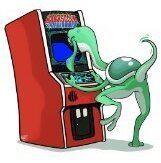
The main issue is that it wasn't counting correctly. In Andromeda SS it has a bonus counter on the bottom that counts down. Basically, it starts at 99, but once it got to 95 it would count weirdly. It would count kinda like this: 95->91->90->81->80->71...
The big thing that I was asked to do was hook my Fluke 9010 to it just to check. I originally wasn't going to be looking into this much due to lack of available time. But I told him if the fluke pointed out something obvious I would try some things.
Basically, first thing I did was do RAM short tests. Typically if RAM has something wrong it will fail during the short test. I tested both the scratch and video RAM as that is all the CPU can both read and write to. From I read the ROMs just to get the checksums, the goal was to be able to see if it matched what was in MAME. However, before I did the comparisons, I did RAM long tests, which is a more thorough RAM test that the fluke can do. To my suprise the video RAM was would fail about 20 seconds or so into the test.
So if the video RAM was flakey, it means that things like counts could get messed up. Looking at it, there are four sets of RAM chips.
Scratch RAM - six 2111 Video RAM - two 2114 Color RAM - eight 2102 Background/stars - three 2102 In my experience, 2114 SRAM ICs can be incredibly problematic. When they start to go they can flat out fail or be inconsistent. So I just went ahead and socketed/replaced them.
After that, I fired the fluke back up and performed the same RAM long test, this time it succeeded. From there I ran the game with the fluke and saw that it was counting just fine. Glad that worked because I wouldn't have had much of an idea on where to go from here.
- Read more...
- 0 comments
- 121 views

